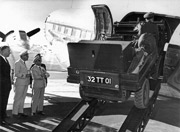 |
|||||||||||||
 |
|||||||||||||
 |
|||||||||||||
 |
|||||||||||||
|
|||||||||||||
|
RhodesiaRhodesian Air ForceIn Rhodesia, some Haflingers were used by the Rhodesian Air Force. Thanks Tony Bourne for sharing his memory with me:
"Yes, the Haflinger was used in the configuration of a radio control vehicle. Because of its short wheel base, fairly high ground clearance, all-wheel drive and narrow track, it was found suitable for
two of these vehicles to be loaded end to end in a Dakota (DC3). However the ramp loading, for me, took some courage. One had to negotiate the ramp in the lowest gear and avoid slipping the
clutch too much. As the front wheels entered the aircraft, one had to start turning left hand down and keeping an eye on the space between the vehicle side rail and the aircraft. With the space OK
and moving to the left, turn more, then check the gap between the right front and the right side of the aircraft, trying to remember if it was purely freight or had pax configuration down each side.
With clearance drive up to front, brake and lash down. It was very tight. Then proceed with No 2. Off- loading, reverse the procedure and keep as slow as possible. In Rhodesien wurden einige Haflinger von der Rhodesian Air Force genutzt. Danke Tony Bourne für seine Erinnerungen: "Ja, der Haflinger wurde in der Konfiguration eines mobilen Funkfahrzeuges genutzt. Aufgrund des kurzen Radstandes, der Bodenfreiheit, des Allradantriebes und der kleinen Spurweite war es möglich, zwei dieser Fahrzeuge hintereinander in eine Dakota (DC3) zu verladen. Die Verladung über die Rampe verlangte mir allerdings einigen Mut ab. Man musste die Rampe im niedrigsten Gang befahren und versuchen, die Kupplung möglichst wenig rutschen zu lassen. Wenn die Vorderrä,der im Flugzeug waren, musste man nach links lenken und ein Auge auf den Platz zwischen Randversteifung und Flugzeug haben. Gleichzeitig versuchte man sich zu erinnern, ob es eine pure Frachtmaschine oder eine Maschine mit Sitzen für Passagiere war. Man fuhr noch ein Stück nach vor und verzurrte das Fahrzeug. Es war sehr eng! Dann dasselbe mit dem zweiten Haflinger. Abladen genau umgekehrt, so langsam wie möglich. Ich hatte Angst, dass der Haflinger beim Befahren der Rampe nach hinten kippen könnte, wenn man auf die Bremse trat, da ein ziemliches Gewicht auf der Hinterachse war. Vielleicht war das nur ich! Das Beladen forderte seinen Tribut von der Kupplung, daher mussten wir die Kupplungsscheiben und die Druckplatten regelmäßig tauschen. Stärkere Druckfedern halfen, die Lebensdauer der Kupplung zu erhöhen. Wenn ich mich richtig erinnere, hatten die Haflinger einen mit Keilriemen angetriebenen Generator und Batterien für den Funkbetrieb. Der Haflinger besaß exzellente Eigenschaften im Gelände, ich fuhr ihn unter anderem in einer aufgelassenen Mine. Sehr eindrucksvoll, sogar unter dem Gewicht der Funkausstattung. Ein ideales Buschfahrzeug." Links
CommentsHere is, where your part of the page begins! If you have anything to contribute, feel free to add a comment! At the moment, there exist no comments for this page yet. |
||||||||||||
|
|||||||||||||
 |
|||||||||||||








